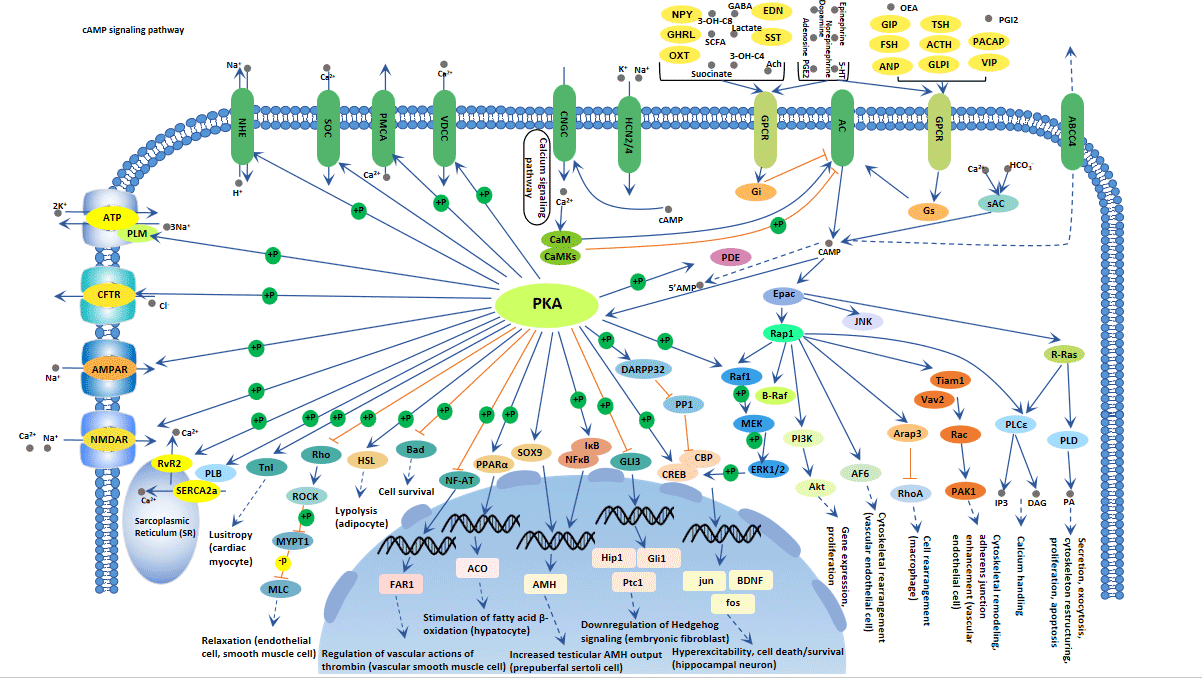cAMP synthesis

Local conditions required for cAMP synthesis

- ATP
- Hormones
- g-proteins
ATP
As cAMP is produced from ATP in one step reaction we can assume that cAMP carries a reliable information about the cell ATP and therefore should activate energy requiring processes
Glasgow University Stephen Yarwood: EPAC - A Novel Route for Specificity in the Cyclic AMP Cascade in Vascular Endothelial Cells

Cyclic AMP Signal Transduction

Larger picture
it is too complex to study it as a whole, better to analyze the system step by step
cAMP and cell proliferation
cAMP can be either mitogenic or anti-mitogenic, depending on the cell type. We demonstrated previously that cAMP inhibited the proliferation of normal renal epithelial cells and stimulated the proliferation of cells derived from the cysts of polycystic kidney disease (PKD) patients. The protein products of the genes causing PKD, polycystin-1 and polycystin-2, are thought to regulate intracellular calcium levels, suggesting that abnormal polycystin function may affect calcium signaling and thus cause a switch to the cAMP growth-stimulated phenotype. To test this hypothesis, we disrupted intracellular calcium mobilization by treating immortalized mouse M-1 collecting duct cells and primary cultures of human kidney epithelial cells with calcium channel blockers and by lowering extracellular calcium with EGTA. Calcium restriction for 3âÂÂ5 h converted both cell types from a normal cAMP growth-inhibited phenotype to an abnormal cAMP growth-stimulated phenotype, characteristic of PKD. In M-1 cells, we showed that calcium restriction was associated with an elevation in B-Raf protein levels and cAMP-stimulated, Ras-dependent activation of B-Raf and ERK. Moreover, the activity of Akt, a negative regulator of B-Raf, was decreased by calcium restriction. Inhibition of Akt or phosphatidylinositol 3-kinase also allowed cAMP-dependent activation of B-Raf and ERK in normal calcium. These results suggest that calcium restriction causes an inhibition of the phosphatidylinositol 3-kinase/Akt pathway, which relieves the inhibition of B-Raf to allow the cAMP growth-stimulated phenotypic switch. Finally, M-1 cells stably overexpressing an inducible polycystin-1 C-terminal cytosolic tail construct were shown to exhibit a cAMP growth-stimulated phenotype involving B-Raf and ERK activation, which was reversed by the calcium ionophore A23187 [GenBank] . We conclude that disruption of calcium mobilization in cells that are normally growth-inhibited by cAMP can derepress the B-Raf/ERK pathway, thus converting these cells to a phenotype that is growth-stimulated by cAMP. Calcium Restriction Allows cAMP Activation of the B-Raf/ERK Pathway, Switching Cells to a cAMP-dependent Growth-stimulated Phenotype*2004
cAMP and Hypertension
Possible role of exogenous cAMP to improve vascular endothelial dysfunction in hypertensive rats. 2006
Fundam Clin Pharmacol. 2006 Dec;20(6):595-604.
Shah DI, Singh M.
Department of Pharmaceutical Sciences & Drug Research, Faculty of Medicine, Punjabi University, Patiala 147002, Punjab, India. dhvanitshah@gmail.com
The study has been designed to investigate the effect of 8-Br-cAMP, an activator of protein kinase A, in hypertension-induced vascular endothelial dysfunction. Rats were uninephroctomized and desoxycortisone acetate (DOCA) (40 mg/kg, s.c.) was administered to rats to produce hypertension (mean arterial blood pressure > 140 mmHg). Vascular endothelial dysfunction was assessed using isolated aortic ring preparation, electron microscopy of thoracic aorta and serum concentration of nitrite/nitrate. The expression of mRNA for p22phox and eNOS was assessed by using reverse transcriptase-polymerase chain reaction. Serum thiobarbituric acid reactive substances concentration and aortic superoxide anion concentration were estimated to assess oxidative stress. 8-Br-cAMP (5 mg/kg, i.p.) or atorvastatin (30 mg/kg, p.o.) prevented hypertension-induced attenuation of acetylcholine-induced endothelium-dependent relaxation, impairment of vascular endothelial lining, decrease in expression of mRNA for endothelial nitric oxide synthase (eNOS), serum nitrite/nitrate concentration and increase in expression of mRNA for p22phox, superoxide anion and serum TBARS. The ameliorative effect of 8-Br-cAMP was prevented by N-nitro-L-arginine methyl ester (25 mg/kg, i.p.) and glibenclamide (30 mg/kg, i.p.). It may be concluded that 8-Br-cAMP may stimulate expression and activity of eNOS and suppress expression of p22phox subunit of NADPH oxidase to reduce oxidative stress and subsequently improve vascular endothelial dysfun
Cyclic AMP serves as a second messenger that regulates a diverse key cellular processes. These include central metabolic events, like gluconeogenesis, glycogenolysis and lipogenesis, cardiac and smooth muscle contraction, secretory processes, ion channel conductance, learning and memory, cell growth and differentiation, apoptosis and inflammatory responses.
Roles of cAMP
Biphasic modulation of insulin receptor substrate-1 during goitrogenesis.2007
Vitamin D: a hormonal regulator of the cAMP signaling pathway. 1999
In the rat thyroid FRTL-5 cell line calcitriol, the biologically most active of the naturally occurring vitamin D metabolites, attenuates both TSH-stimulated cAMP production and the effects of cAMP.